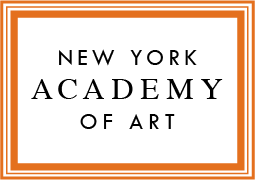Students enroll in two elective courses over their one-year certificate program. The Academy offers a selection of electives that vary each semester. Below is a list of recent offerings.
+
CFA - ED503 | Structural Drawing
Drawing from casts represents a quintessential practice within the academic curriculum. The Academy’s cast collection is a treasured repository of sculptural forms from Classical Antiquity and the Renaissance. As examples of great sculptural art, the casts reward close study with insights into how reality is abstracted, simplified, clarified and translated into artistic form. In addition to careful study of the full-size casts, particular attention is directed toward heads, facial features, hands, feet and drapery. Artistic theories of light and shade are presented. Both linear and dimensional depictions of sculptural form are extensively explored.
3 credits
Core Learning Outcomes
- Develop an understand the complexity of the human figure and other subjects in terms of simpler mass concepts
- Draw the figure and other subjects, both as a whole and in part, with clarity and understanding by determining the design aspects and considering the fundamental building blocks of structure
- Develop ability to draw proficiently from life and imagination
+
CFA - ED504 | Perspective
This course is intended to introduce linear perspective as a more advanced system for creating pictorial space on a two-dimensional surface, and most importantly as tool for influencing our memory and therefore content. Perspective has the ability to both define space and remove us from reality. Students will become more familiar with the analytical approach to the language of perspective. The objective is to begin a deeper investigation into how objects and figures effect our perception of space. By observing how three-dimensional forms project onto a two-dimensional grid students can begin to understand how the geometric structures found in human anatomy relate to a linear system.
3 credits
- Learn how to depict a model in space using constructed methods of Linear Perspective
- Analyze the changing landscape of pictorial space by appreciating the advancement of linear in the 14th century into the 21st century
- Develop a composition in Plan View then project both figures and objects in space
- Generate and illustrate a grid in one and two-point perspective with an emphasis on eye level, cone of vision, vanishing points, and measuring points
- Advance practical application of linear perspective by placing three-dimensional figures and objects in a two-dimensional space without construction of a grid
- Use “perspective scale” in order to more closely represent visual relationships.
- Affect the viewer’s experience by way of an illusionist space – “It is a subtle role, having to do with the spectator’s experience of his or her location in space with respect to the physical surface of the painting”
- Use geometrical forms relating to anatomical structures to render a figure defined within a perspectival system
Understanding that perspective is a way to situate and communicate light - Use perspective to depict space displaced by the model
+
CFA - EH501 | Theory of Color & Composition
The purpose of this class is to introduce the theory and practical application of color and design for artists. During the first half of the semester, the class will explore the fundamental historic aspects of Western pictorial design and its use by artists to compose organized and compelling visual arrangements. The second half of the semester will be devoted to developing in the students an understanding of the language of color, ways to achieve color harmony, and a sound and practical method for controlling color in both palette layout and application.
3 credits
Core Learning Outcomes
- Demonstrate an understanding of how to establish complex color strings, practically mix and employ subtle color gradations
- Comprehend and utilize seven common color harmonies
- Understand and employ the basic elements of design and integrate this information into specific frames of reference based on geometric construction and harmonic proportions
+
CFA - EA501 | Ecorche
This course provides a thorough analysis of human anatomy through the construction of an écorché (an anatomical sculpture of a flayed figure). Each student begins by sculpting a skeleton out of plastilene, onto which is attached first the deep and then the superficial muscles of the body. Relying on Old Master drawings, diagrams, specially prepared dissection casts and the live model, the instructor demonstrates how the forms of the bones, muscles and tendons are transferred to the écorché.
3 credits
Core Learning Outcomes
- Develop a conceptual and perceptual understanding of the anatomical, proportional, axial, mass and planar relationships necessary to the representation of a convincing human form in standing reference pose and in movement
- Interpret the forms of the live model and work more effectively from the imaginations, with or without a live model or a photo reference
+
CFA - ES502 | Sculpture II
This course is designed to recapitulate the fundamental ideas presented in sculpture one, although at a larger scale and over an extended period of time, they are: proportion, linear and volumetric, the sculptures relation to the ground plane, i.e. the main plumb line, carrying angles of all elements of the figure, the essential geometry underlying and describing the structural characteristics of the body, the conversion of the perceptual experience of the model’s body into sculptural convention.
Additional concerns to be discussed during the semester are: compositional organization of interior forms, their relationship to anatomical structures, and methodologies of modeling technique to represent these structures. Surface development will be discussed in terms of surface tension(s), and as the student’s ultimate understanding of form development.
3 credits
Core Learning Outcomes
- Further develop the students analytical and perceptual abilities
- Learn to work at an incrementally larger scale, approaching life scale
+
CFA - ES503 | Unusual Materials
TBA
